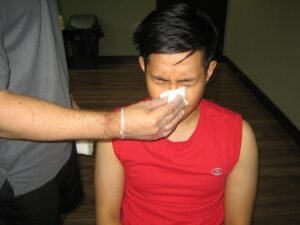A nosebleed or epistaxis can look frightening and uncomfortable, but it is not dangerous. Children are more prone to nosebleeds than the adults, since it can be due to the irritation of the nasal membrane or from trauma. If an adult gets a nosebleed, it can indicate a severe medical problem. With this in mind, it is important to consult your doctor if you have a bloody nose, particularly those not caused by physical trauma.
First aid for a nosebleed
If an individual has a bleeding nose, there are first aid measures that you can perform in order to stop the bleeding.

- As a fundamental rule when delivering first aid, always observe safety by following the universal precautions and use protective equipment if available. Take note that the bleeding nose of the individual might be due to trauma. Always make sure that you are not going to end up hurt while helping out the individual.
- You have to position the individual in a leaning forward position. Do not lean back since the blood will go down the throat and block the airway or go to the stomach, thus irritating the stomach lining and causing the individual to vomit.
- Pinch the nose right below the bony bridge. Your fingers must be positioned on the soft tissues as well as the bone. In case the blood continues to flow, simply adjust your grip. When holding the nose, this should stop the bleeding. The blood vessels in the nasal membrane can be pressed on the bony bridge in order to minimize the flow of blood and eventually generate a clot.
- After 5 minutes, you have to release the pressure to check if the bleeding has stopped. In case the bleeding continues, continue holding the nose for 10 minutes. Just remember not to release just to check the bleeding until 10 minutes is reached. You have to repeat for another 10 minutes if needed.
- In case the nosebleed has not stopped after the second or third try, it is best to seek medical care. If the individual feels dizzy, lightheaded or weak, call for emergency assistance. Take note that if not treated right away, it can lead to shock.
Useful tips when dealing with a nosebleed
You can apply ice or cold pack over the bridge of the nose since it will constrict the blood vessels and help stop the bleeding. This approach can be used along with pressure.
Once the bleeding is controlled, instruct the individual to avoid blowing his/her nose. By blowing the nose, it will release the clots and can trigger bleeding again.
Majority of cases involving a bleeding nose are due to nasal membranes that are dry or injury. Nevertheless, some tend to happen unexpectedly and can indicate a serious medical problem. It is best to contact a doctor if the individual is suffering from recurrent or difficult to control epistaxis.
As for a bleeding nose due to trauma to the head, it can indicate a brain injury, especially if the bleeding occurs without any obvious facial injury. In case the individual suffered from a severe trauma such as a fall or vehicular accident and bleeding from the nose, immediately call for emergency assistance.
